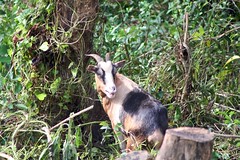 |
| backyard goat (Photo credit: eschipul) |
Dear 5th District Resident,
I will be absent from City Council on July 16, 2013 as I had scheduled a short vacation in conjunction with a required meeting in Sacramento at the Medical Board on California on which I serve as a public representative.
I will be absent from City Council on July 16, 2013 as I had scheduled a short vacation in conjunction with a required meeting in Sacramento at the Medical Board on California on which I serve as a public representative.
On July 16, 2013, the Council is being presented with
initial recommendations on the issue of urban agriculture regarding the
expansion of the areas where chickens, goats and bees may be allowed. Should the
Council support allowing these animals and bees, the City Attorney will be
instructed to draft an ordinance that will then be brought back to City council
on two separate times for votes.
I am hopeful the Council can strike a balance between
allowing residents to utilize their back yards for self-sufficiency,
sustainability and an appreciation of nature and growing things, and a concern
for the impact upon those residents who do not want residential areas used for
such purposes.
I would urge my colleagues to
consider adopting similar rules as did the City of Portland, Oregon which
require that in order to keep goats, chickens and bees, all property owners and
residents within 150 feet of a proposed location for these animals MUST be
notified. This prevents conflict from surprised neighbors, allows
problem-solving to occur early in the process and reduces complaints. Additionally,
Portland has the following requirements related to the animal facilities that
must be maintained to house these animals so that the animals can be properly
cared for kept in yards (minimizing wild goose chases around the neighborhood).
A planned facility in
Portland: is in good repair; won't disturb neighbors; has absorbent ground
cover (that can be replaced as often as necessary to suppress odor); has a
secure enclosure; provides animals with adequate lighting and ventilation; is
15 feet from residential buildings (not including your own); and uses feeding
practices that won't attract unwanted rodents and predators.
 A minimum of 2 square feet of
floor space (per bird) in the roosting shelter is recommended. Outside, a
minimum of 10 square feet of enclosed area per bird is recommended. In addition,
a thick replaceable ground cover such as straw or wood shavings must be used.
A minimum of 2 square feet of
floor space (per bird) in the roosting shelter is recommended. Outside, a
minimum of 10 square feet of enclosed area per bird is recommended. In addition,
a thick replaceable ground cover such as straw or wood shavings must be used.
Animal owners also need a plan
for disposing of excrement in a safe manner.
 Finally, in those cities that
already allow urban livestock, they are experiencing an additional problem that
needs to be addressed upfront: the abandonment of chickens and goats after
residents tire of them or are unable to care for them. As an article in E-Environmental Magazine
stated: For many urban agrarians,
chickens and goats are the perfect addition to a backyard farm, providing eggs
and milk to complement bumper crops of tomatoes and peas. But when the novelty
of having a chirping chick wears off or adorable kids turn into grownup goats
that eat the landscaping, the animals are often surrendered to rescue groups or
abandoned. - See more at: http://www.emagazine.com/magazine/urban-homesteadings-dark-side#sthash.qicjkpLY.dpuf
Finally, in those cities that
already allow urban livestock, they are experiencing an additional problem that
needs to be addressed upfront: the abandonment of chickens and goats after
residents tire of them or are unable to care for them. As an article in E-Environmental Magazine
stated: For many urban agrarians,
chickens and goats are the perfect addition to a backyard farm, providing eggs
and milk to complement bumper crops of tomatoes and peas. But when the novelty
of having a chirping chick wears off or adorable kids turn into grownup goats
that eat the landscaping, the animals are often surrendered to rescue groups or
abandoned. - See more at: http://www.emagazine.com/magazine/urban-homesteadings-dark-side#sthash.qicjkpLY.dpuf
The article also points out that
“urban animal shelters are not designed to house livestock” and neither is the
City of Long Beach’s Animal Services Shelter.
These issues need to be
addressed before any changes are made in the City’s code so that urban
agriculture can be supported in a responsible, neighborhood friendly manner.







